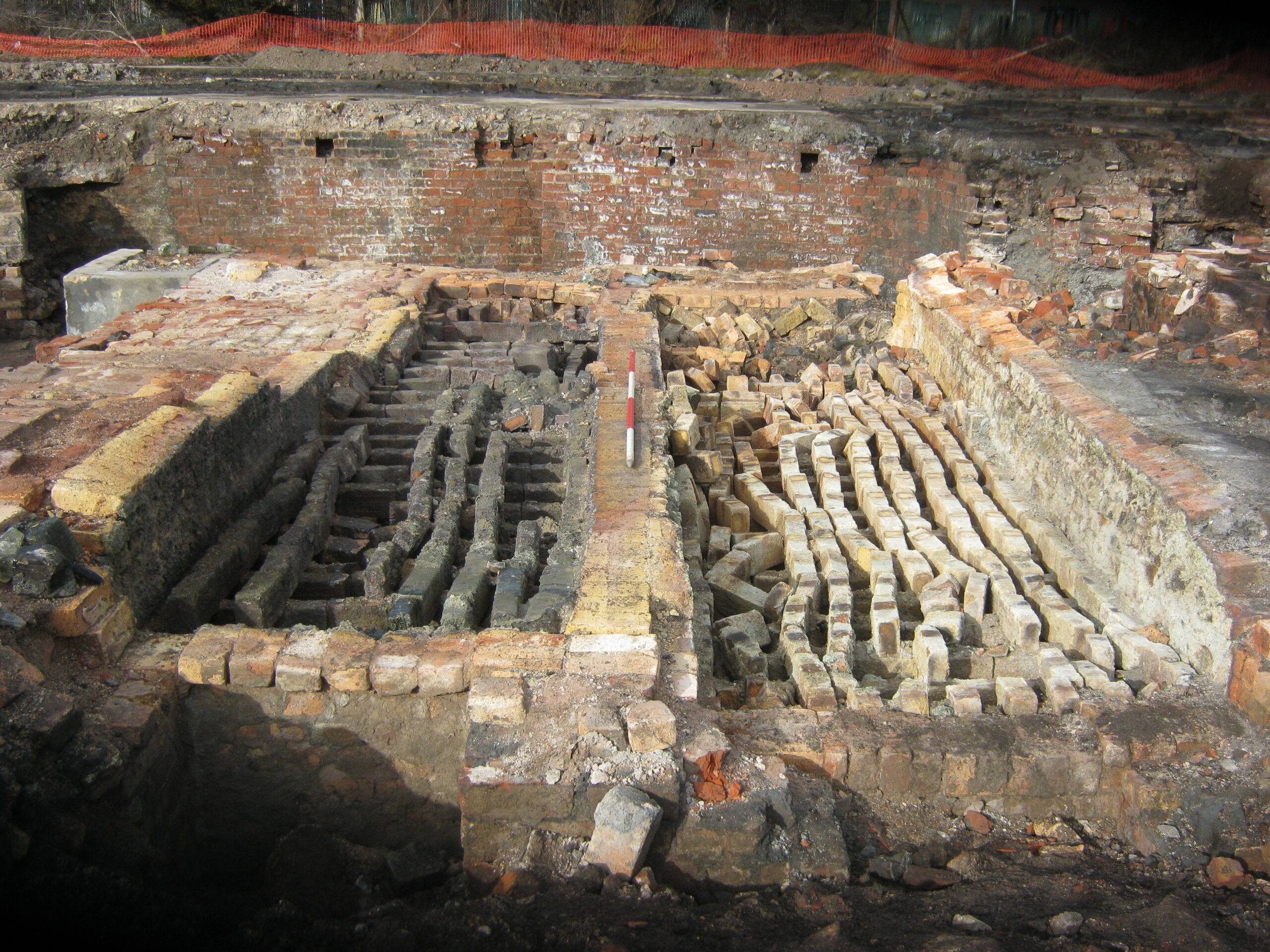Brick kilns, glassworks, and huge deposits of artefacts were found during development works at Baileyfield, Portobello. The structures and finds represent several different industrial activities taking place in the area between the 18th and 20th centuries.

AOC Archaeology undertook the excavations between 2017 and 2019 on behalf of Barratt Homes, as advised by the City of Edinburgh Council Archaeology Service (CECAS).
The works at Baileyfield provided an opportunity to explore Portobello’s industrial heritage and gain insight into how the different factories operated and worked alongside each other. The excavations revealed substantial surviving remains of brick and sandstone surfaces, walls, kilns, chimneys, and flue systems.
These relate to multiple phases of the 18th to 20th century Abercorn Brick and Tile Works as well as the 19th to 20th century glass and bottle works owned by Cooper and Wood and United Glass Bottle Manufacturers amongst several others. The area was covered by up to 4m of dumped material including bricks, glass bottles and objects, and ceramics and stoneware from the surrounding potteries.

Abercorn Brick and Tile Works
The Brick and Tile Works were established at the end of the 18th century after the discovery of clay pits on the Abercorn estate. Around 1807, the area known as Baileyfield passed into the ownership of Mr William Creelman, with the first cartographic depiction of the site appearing on John Wood’s town plan of 1824 (view map) on the south side of Fishwives’ Causeway. After Creelman’s death in 1830, ownership of the Works passed to his daughters Catherine and Isabella, who founded the company C Creelman & Co.
Over the course of the 19th century, ownership of the Works passed from the Creelmans to the Livingston family in 1845, then to Messers Thomas Thornton and Sons in 1882, and finally to Turners Ltd in 1893. Several changes to the layout were implemented during this time, including expansion to include further large buildings, circular structures, a Bottle Works, and a tramway linking the buildings to nearby clay pits along the Figgate Burn as seen on the Ordnance Survey second edition map (view map). At its height, the Works may have employed around 100 men.
Bottle Works
The Bottle Works adjacent to the Brick and Tile works were originally owned by Mr Astley and passed to William Bailey in 1829, who gave the area its name of Baileyfield. Production was originally for flint glass before converting to produce green glass bottles. After Bailey’s death in 1859, Bailey’s partner, Richard Cooper, took over the business with his brother-in-law, but the two men had a disagreement and the property was split between the two. Like the Brick and Tile Works, the site saw much change and expansion over the late 19th century.
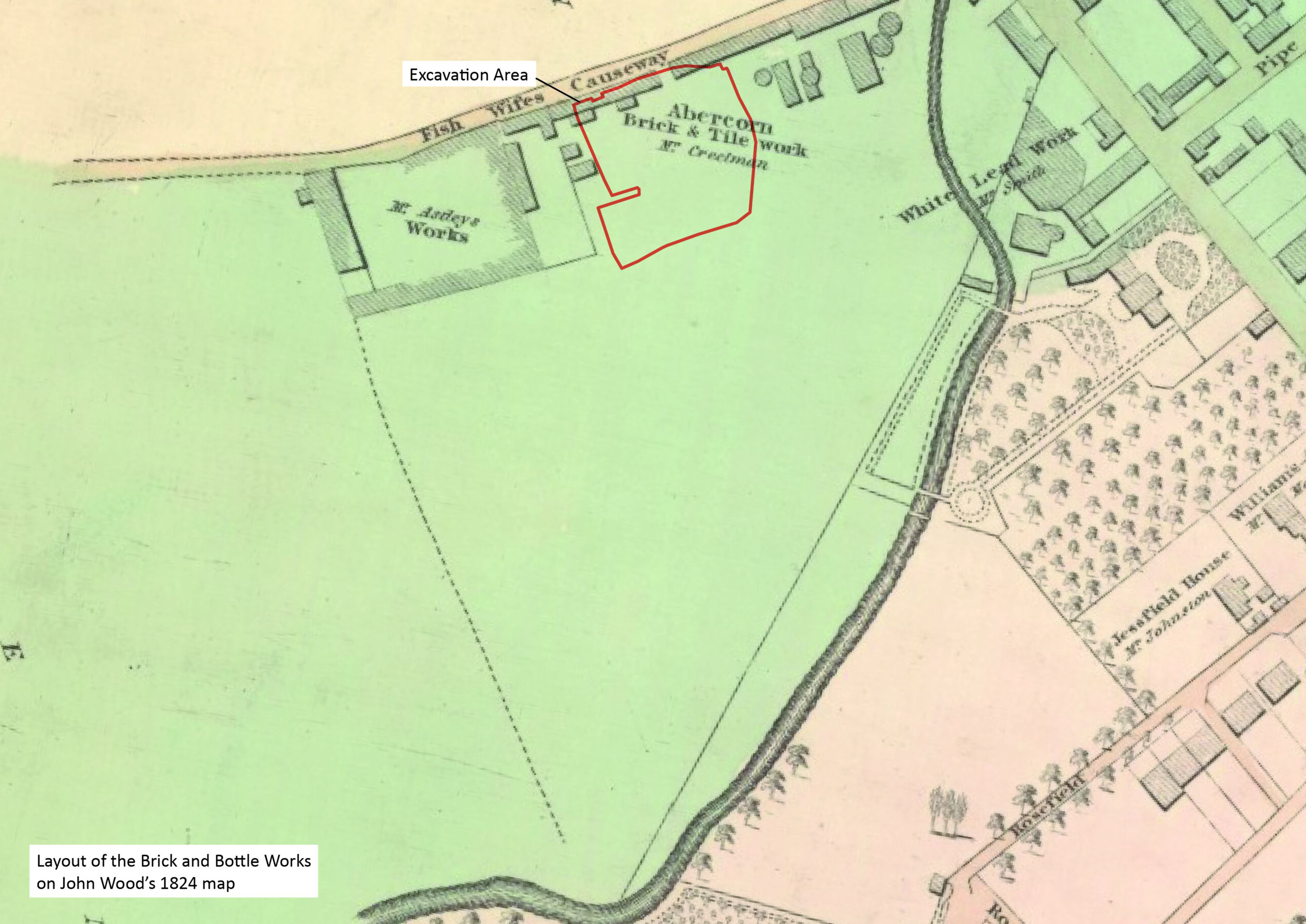
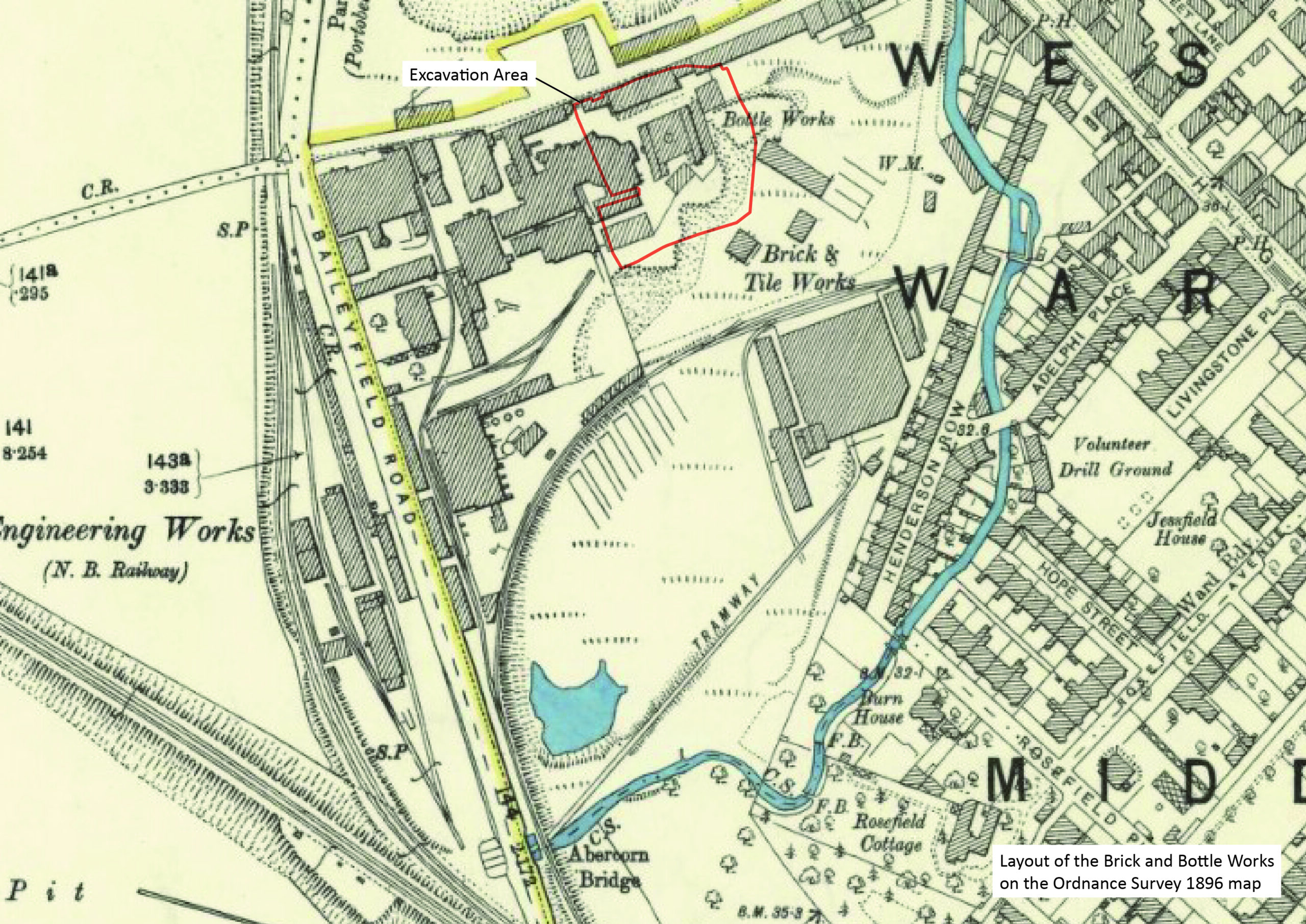
Historic maps reproduced with the permission of the National Library of Scotland https://maps.nls.uk/

Decline of the Industries
In the early 20th century the Brick and Tile Works fell into decline, with the company facing major losses from flooding and a trial where it was claimed that the digging of clay pits was causing the nearby railway to subside. The site was put up for sale in 1909 and by 1912 the works were derelict and mostly dismantled. The area was later levelled and used as a football ground by the 1930s.
The Bottle Works remained in operation for longer, and thrived from the late 1920s with the introduction of automatic bottle making machines. In 1937, the Bottle Works were taken over by United Glass Bottle Manufacturers Ltd, who built new furnaces and made many improvements to working conditions following World War II. The improvements were described in detail by H.A. Basterfield, the last works manager at the site, and can be read here. The closure of the works in 1967 came as a surprise to many of the workers. The glassworks structures were demolished between the 1960s-80s and replaced by Baileyfield Industrial Estate.
The Excavation
The excavation works uncovered various structures and features associated with the Abercorn Brick and Tile Works and Bottle Works. The surviving structures included the remains of brick buildings used for storage or workshops, brick kilns used for firing bricks, and brick-drying areas used to dry the bricks before firing. The structures were all linked by a network of flues, tunnels, and chimneys. Although originally built as a brick works, many of the structures were reused within the later Bottle Works.
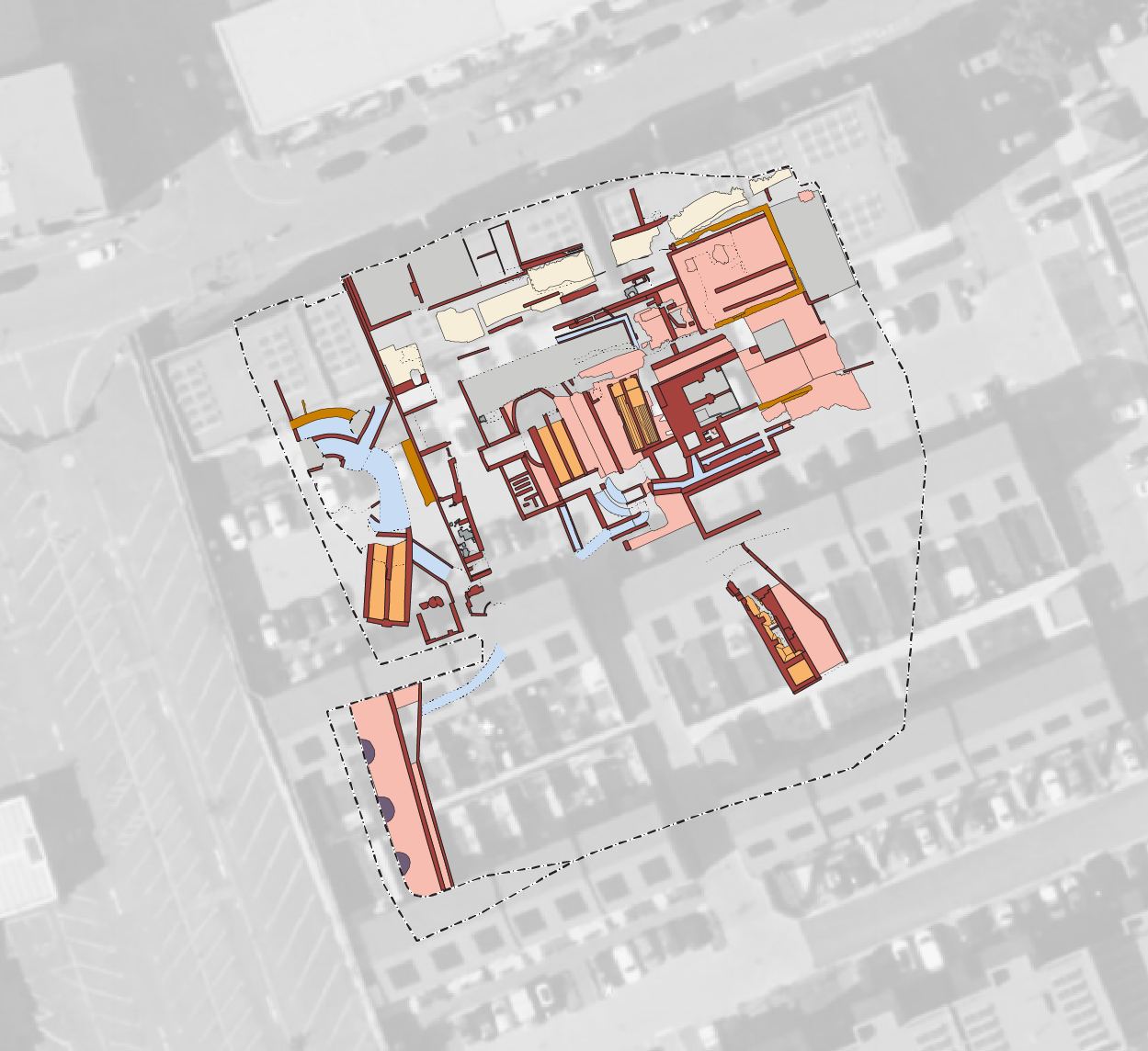
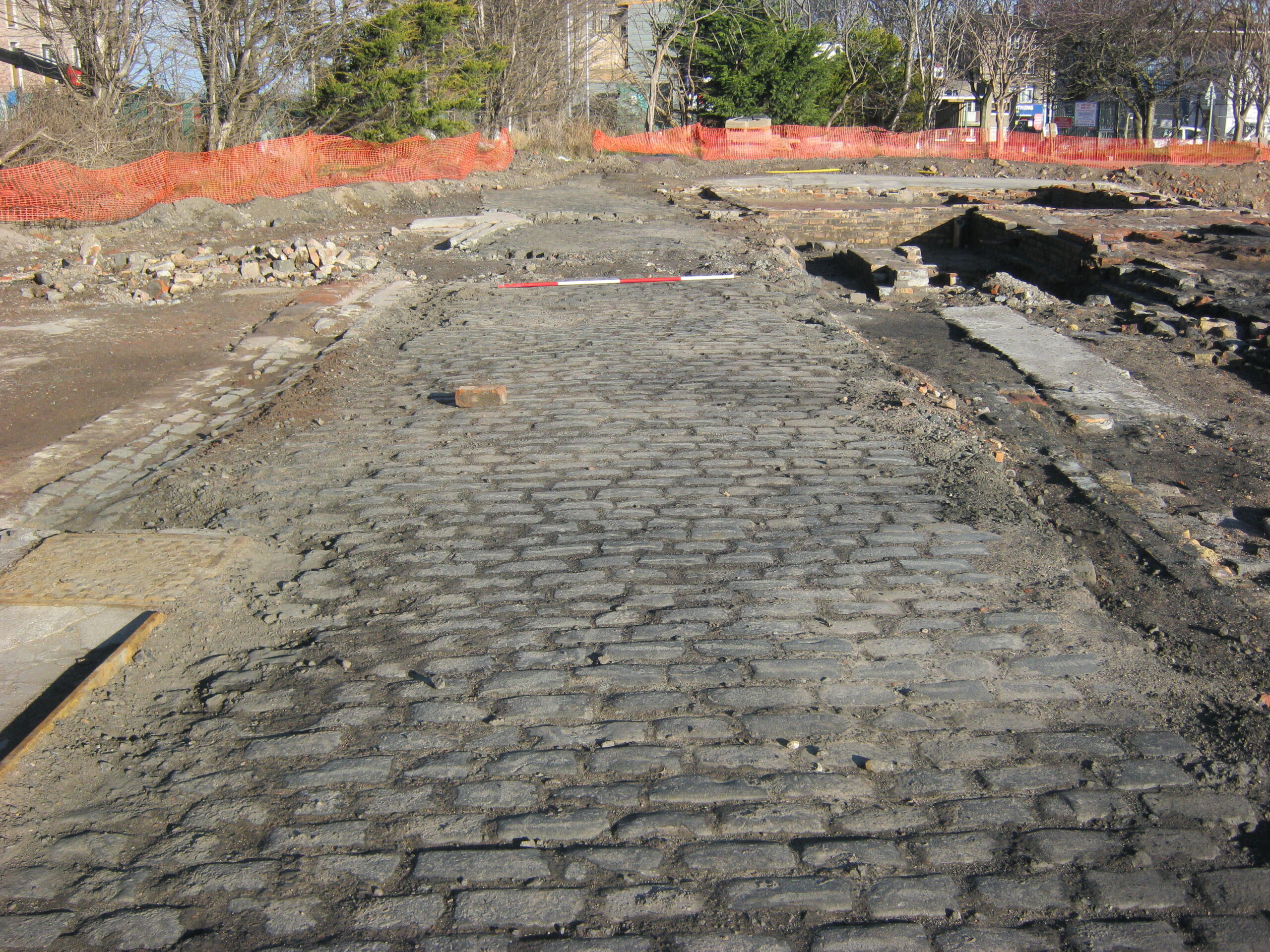 Access Road: The remains of an access road from Portobello High Street to the Brick and Bottle Works constructed with blue granite setts. Although historically, there has been a road in this location since at least 1856, this appears to be of early 20th century date.
Access Road: The remains of an access road from Portobello High Street to the Brick and Bottle Works constructed with blue granite setts. Although historically, there has been a road in this location since at least 1856, this appears to be of early 20th century date. Brick Works Building: This rectangular building was one of the earliest in the Brick Works and has seen several instances of use, repair, and adaptation. It was initially built with sandstone with later brick walls added as the function of the building changed.
Brick Works Building: This rectangular building was one of the earliest in the Brick Works and has seen several instances of use, repair, and adaptation. It was initially built with sandstone with later brick walls added as the function of the building changed.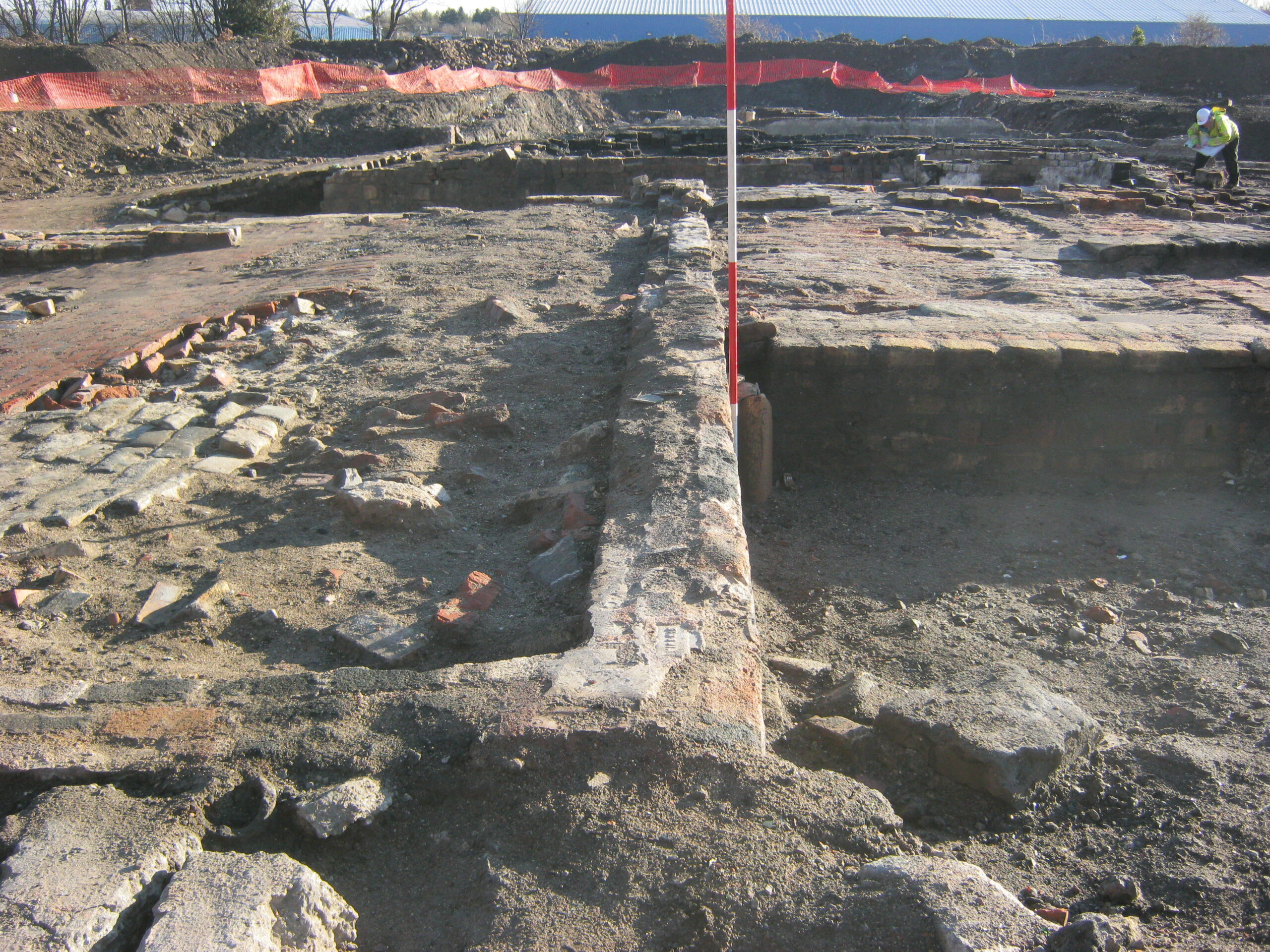 Brick Works Buildings: As the Brick Works expanded post-1825, further buildings were added built with brick walls and handmade brick floors. These buildings contained flues that connected the nearby brick-drying area to a chimney.
Brick Works Buildings: As the Brick Works expanded post-1825, further buildings were added built with brick walls and handmade brick floors. These buildings contained flues that connected the nearby brick-drying area to a chimney.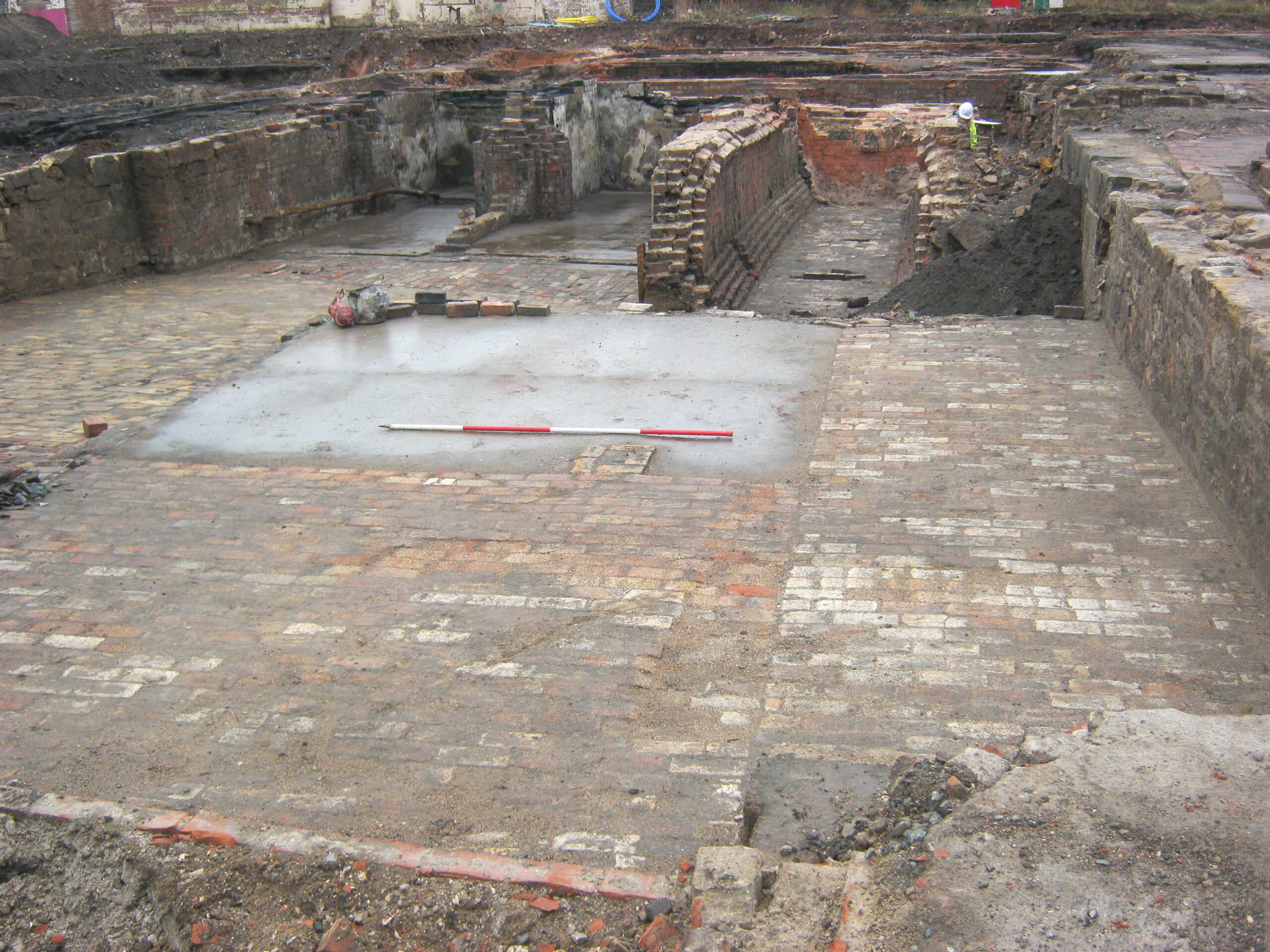 Ramp and Cellar Complex: A brick ramp sloped down to provide access to a series of cellars and tunnels which were used as storage areas for the Brick Works. Several different floor areas were identified during excavations, suggesting changes in usage as they migrated from the Brick Works to the Bottle Works.
Ramp and Cellar Complex: A brick ramp sloped down to provide access to a series of cellars and tunnels which were used as storage areas for the Brick Works. Several different floor areas were identified during excavations, suggesting changes in usage as they migrated from the Brick Works to the Bottle Works. Chimney and Flue Complex: The chimney and flue network was constructed for the 19th/20th century brick works and was linked to various kilns and brick drying areas. It was likely reused within the later Bottle Works.
Chimney and Flue Complex: The chimney and flue network was constructed for the 19th/20th century brick works and was linked to various kilns and brick drying areas. It was likely reused within the later Bottle Works.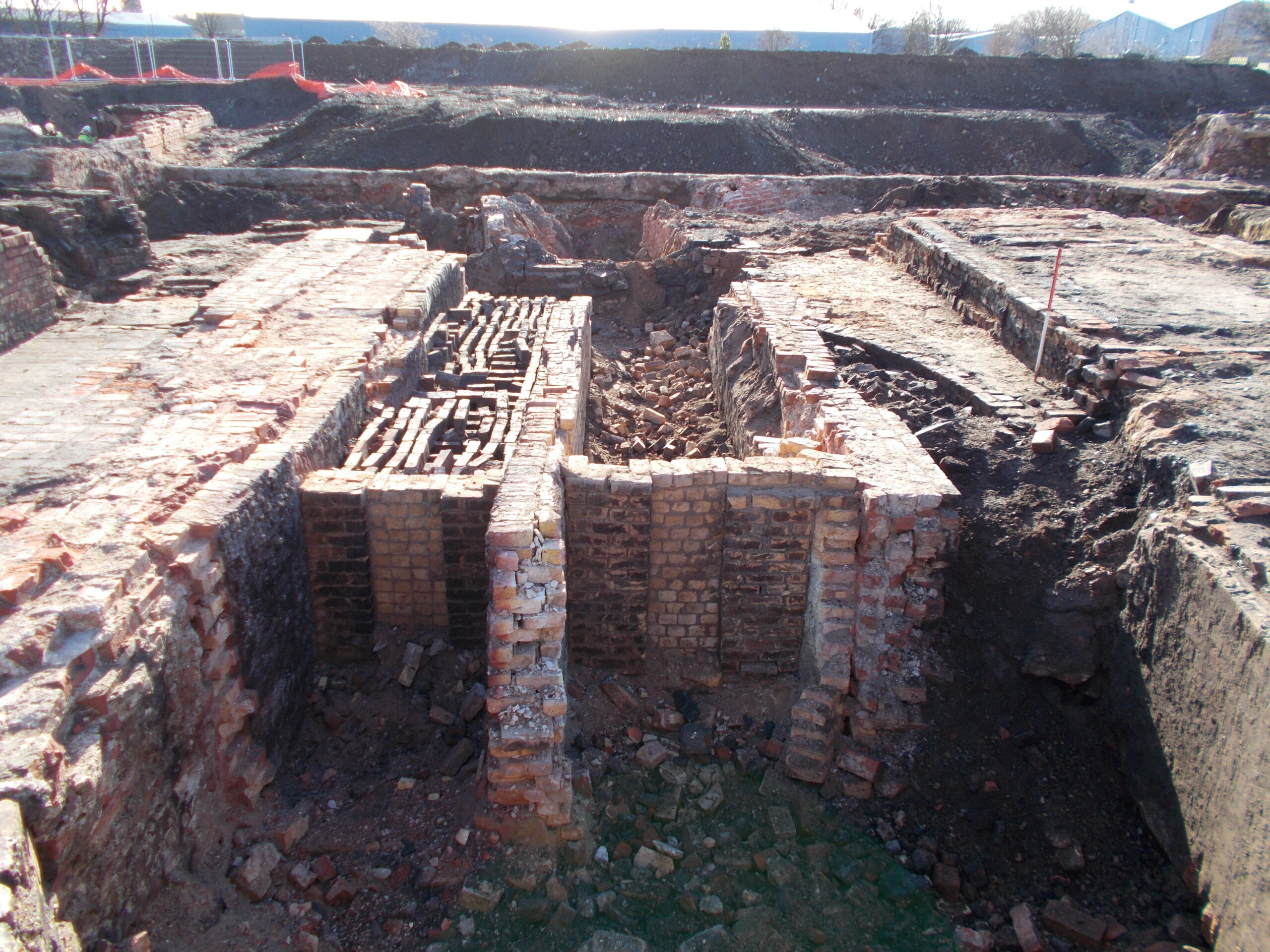 Brick Kilns: Four brick kilns were uncovered in this area, with three still containing their final load of fire-clay bricks branded with the name ‘STEIN’. These kilns connected to the wider network of flues and chimneys.
Brick Kilns: Four brick kilns were uncovered in this area, with three still containing their final load of fire-clay bricks branded with the name ‘STEIN’. These kilns connected to the wider network of flues and chimneys. Original Brick Kiln: The four kilns in this area were partly built within the remains of an earlier kiln, which was likely the original brick kiln associated with the first iteration of the Brick Works.
Original Brick Kiln: The four kilns in this area were partly built within the remains of an earlier kiln, which was likely the original brick kiln associated with the first iteration of the Brick Works.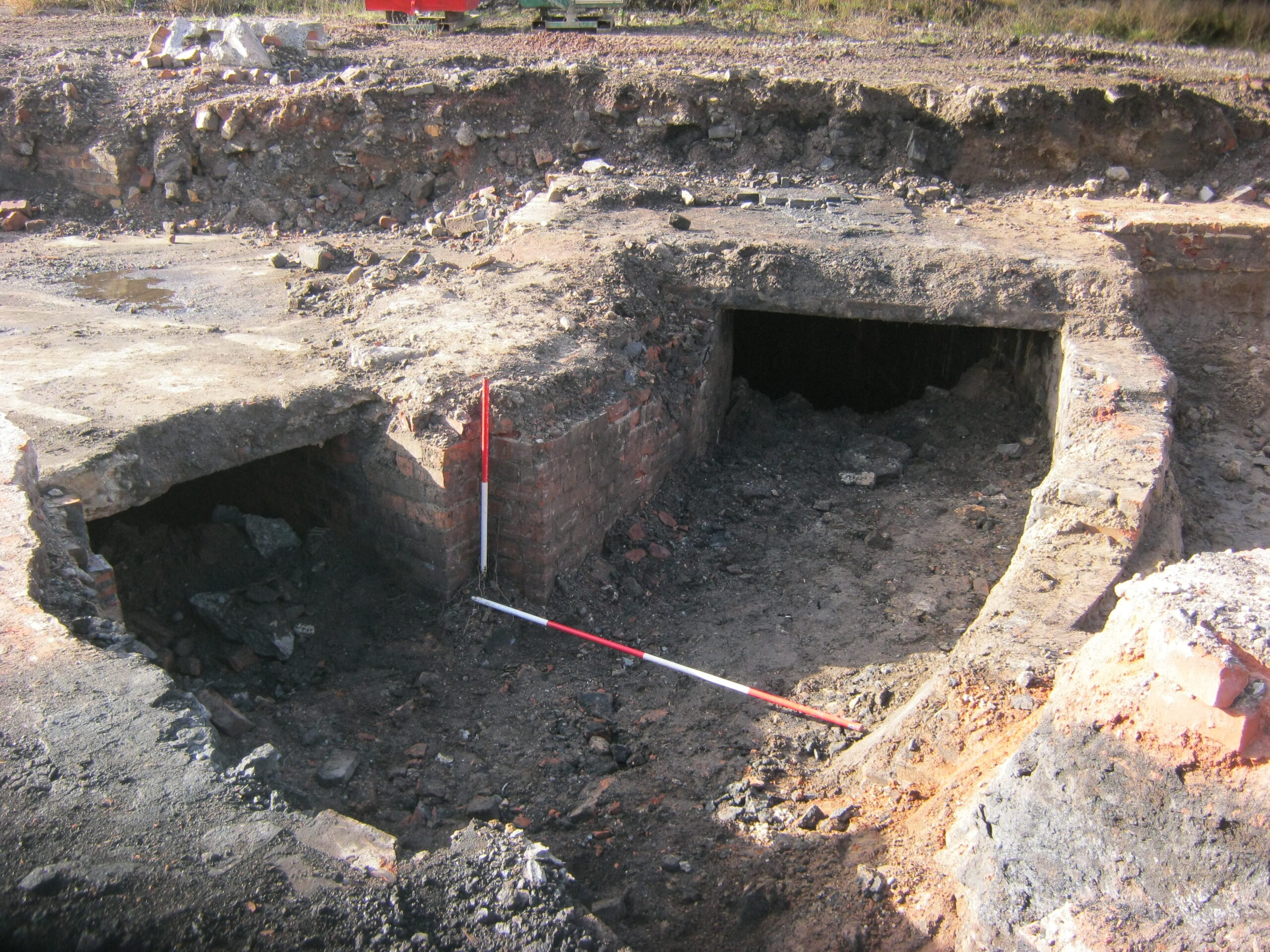 Early Flue and Kiln System: A system of flues and associated buildings, walls, and surfaces was located here along with further brick kilns.
Early Flue and Kiln System: A system of flues and associated buildings, walls, and surfaces was located here along with further brick kilns. 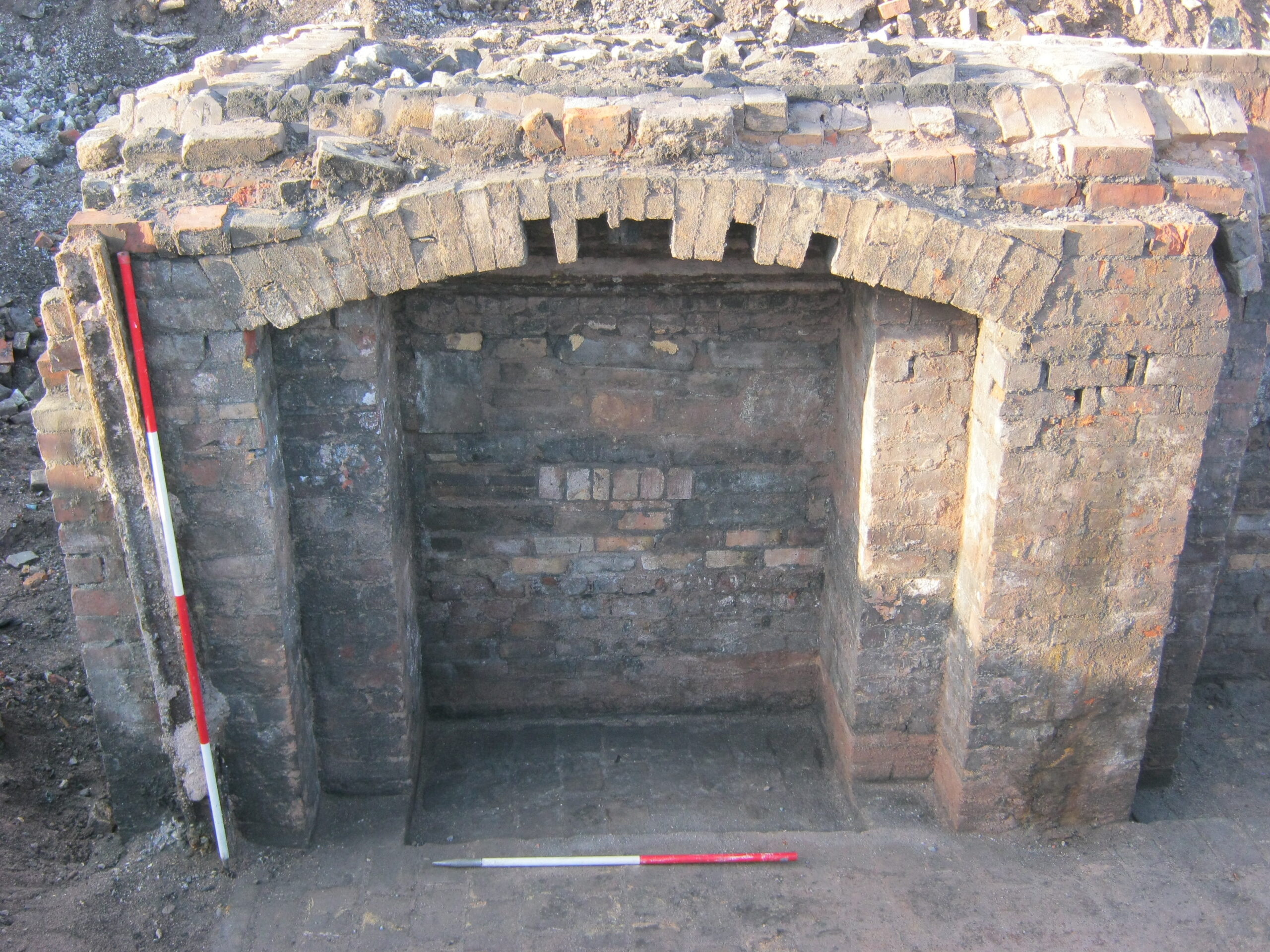 Glass Production Room: This building contained a fireplace, chimney, and three small glass kilns.
Glass Production Room: This building contained a fireplace, chimney, and three small glass kilns.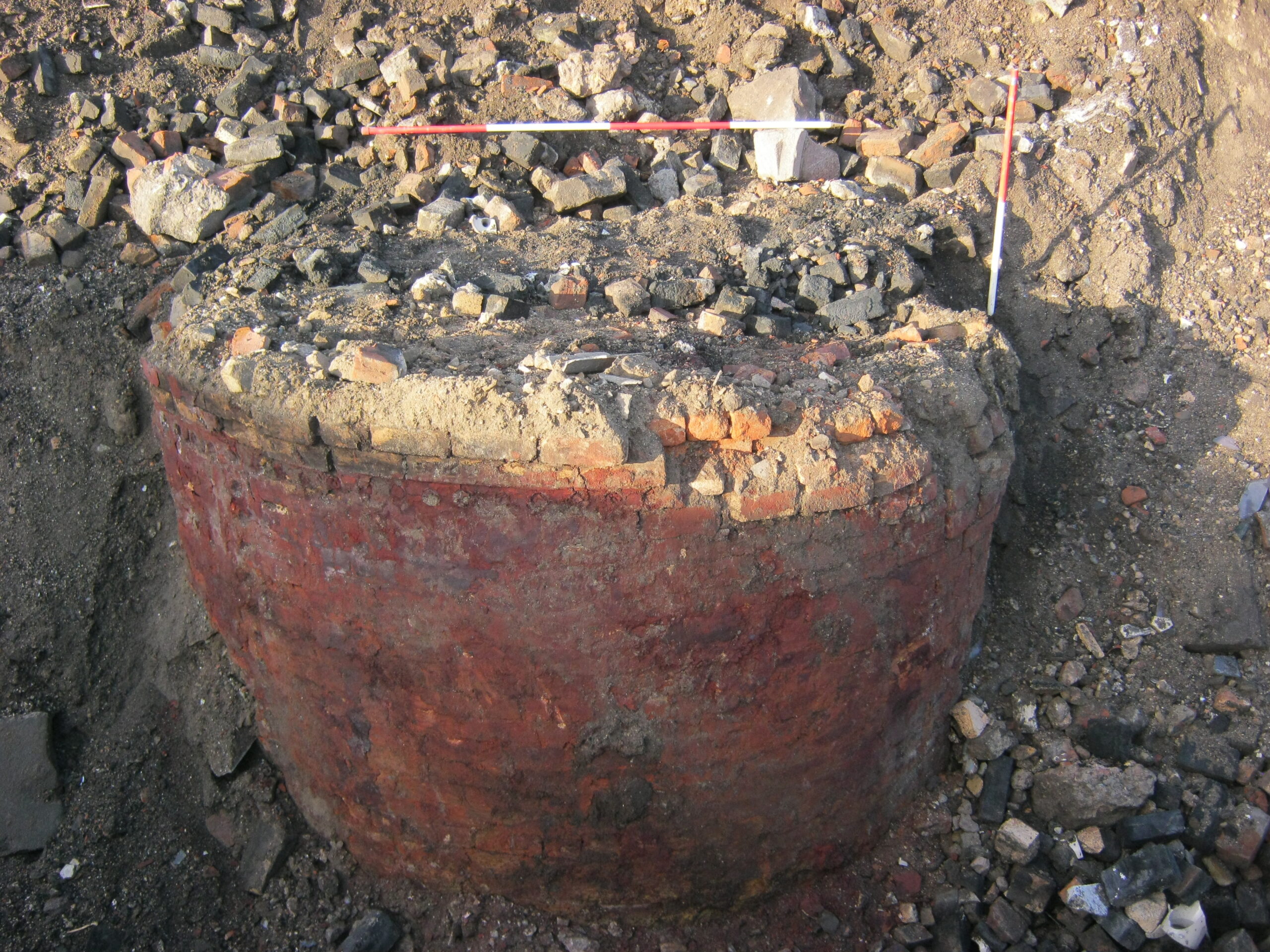 Chimneys
ChimneysGlassworks Artefacts
Numerous glass bottles were recovered from the site (many of which were substantially intact), but surprisingly few were associated with the actual glassworks on the site and are instead likely to be domestic refuse from Portobello. This is likely because any glass vessels produced on the site would have been sent out for sale and only defective or waste pieces of glass would have remained on site. Glass waste was found during the excavations in the form of large and small angular lumps that were probably smashed out of the crucibles as a waste product after casting or as runs of molten glass created by run-off from the casting and moulding process of bottles. A few fragments of refractory ceramic kiln props were also found with glass waste adhering to them.
Buchan’s Stoneware
Most of the ceramic artefacts from the site were items of stoneware from A.W. Buchan’s nearby pottery works, which had its final kiln firing in 1972. The artefacts were dumped at Baileyfield because they were found to be defective in some way, with evidence of uneven glaze, glaze crawl, smudged hand-painted decoration and fuzzy transfer printed labels found on many items. Some were remarkably intact and it’s not clear in all cases why they were discarded.
A variety of household tableware was found, representing dinner services, casserole dishes, serving dishes, plates, bowls, milk or cream jugs, butter dishes, oil and vinegar bottles and honey pots. These were hand-painted with garish polychrome designs, with many falling into distinctive styles created by female designers and painters. These included the thistle with bluebells and heather motif designed by Miss Grace Blair, ‘Riviera’ and ‘Brittany’ designed by Lady Milne, ‘Rouen’ designed by Miss Irene Eyers, and ‘Hebrides’ designed by Miss Lynn Kerr.
Bottles and Jars
Stoneware bottles and jars were found in a variety of sizes, most of which had a plain exterior. This allowed the bottles to be sent away to various other manufactories where they would be filled with a product and a paper label applied by the company.
Alcohol Containers
Buchan’s produced a lot of alcohol containers, particularly whisky flagons, which were often pre-printed with the distillery information allowing them to be filled by the distillery and immediately sent out to sale. Whisky varieties represented on the site included ‘Blue Cap Claymore Scotch Whisky’, ‘Munro’s King of Kings Very Rare Old Whisky’, and ‘Catto’s Extra Special Scotch Whisky’. A number of miniature flagons stamped with ‘Auld Lang Syne’ were also found.
Other Ceramics
A range of small food and drink containers were recovered, which would have contained consumable products. These vessels were often transfer printed with labels identifying the maker and product, with examples from ‘Young’s Morecambe Potted Shrimps’ and ‘Numol Lecithin Food Body Builder’.
Fragments of hot water bottles and their stoppers were found amongst the ceramics. These came in three sizes: 1½ pint, 2 pints, and 3 pints. A notice was printed on the top reading ‘Heat this bottle before filling it with boiling water’.
Buchan’s were famous for their ‘portovases’, an enlongated pyramidal vase often marked ‘In Memoriam’ that could be stuck into the ground beside a grave and filled with flowers.
Artefacts recovered from Baileyfield will be submitted and allocated via the Scottish Archaeological Finds Allocation Panel (SAFAP) who advise the King’s and Lord Treasurer’s Remembrancer (KLTR) on Treasure Trove.
explore the 3D models⚬
explore the 3D models⚬
explore the 3D models⚬
explore the 3D models⚬
explore the 3D models⚬
Teapot
This teapot was found amidst the thick layers of 19th and 20th century debris covering the site. It is iron sheet construction with a roughly barrel-shaped body, teardrop-shaped handle, and a largely vertical spout. It has a yellow enamelled body with a white interior and black spout and handle.
Whisky Flagon – King of Kings
Complete stoneware flagon, Buchan’s form 26 with brown dipped shoulders, neck rim and handle. Printed on the front in black reads ‘MUNRO’S KING OF KINGS / VERY RARE / OLD WHISKY / JAMES MUNRO AND SON, LTD / BLENDERS AND EXPORTERS / LEITH, SCOTLAND’. Impressed on bottom ‘B2’. Recovered during the evaluation phase in Trench 5 at Baileyfield.
Whisky Flagon – Blue Cap
One substantially complete mid-20th century stoneware flagon with blue dipped top. The blue transfer print on front reads ‘BLUE CAP / CLAYMORE / SCOTCH WHISKY / SOLE PROPRIETORS GREENLEES BROS / LEITH & LONDON’. The base has an impressed B… Greenlees Brothers, which was included on a list of distillers in an 1874 publication called ‘London and Suburban Licensed Victuallers Hotel and Tavern Keepers’.
In 1919 they merged with William Williams & Sons Ltd, builders and owners of the Glendullan Distillery, to form MacDonald, Greenlees & Williams (Greenlees belonged to Alexander & MacDonald at that time). This company listed three brands in a 1924 overseas advertisement: Claymore, Old Parr, and Sandy MacDonald (Sandy Mac). MacDonald Greenlees & Williams joined the Distillers Company Ltd. in 1925, and at the same time shortening their name to Macdonald Greenlees and eventually, ending up as part of based in Maritime Street, Leith.



